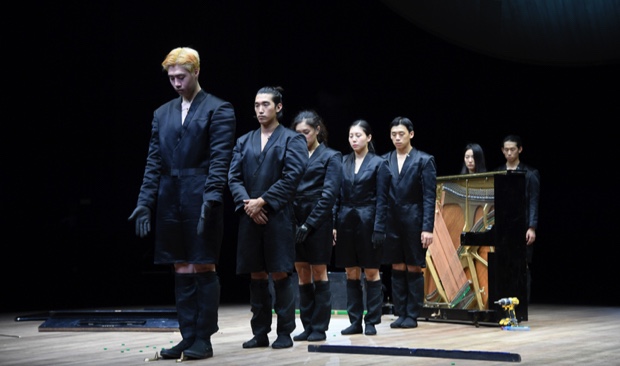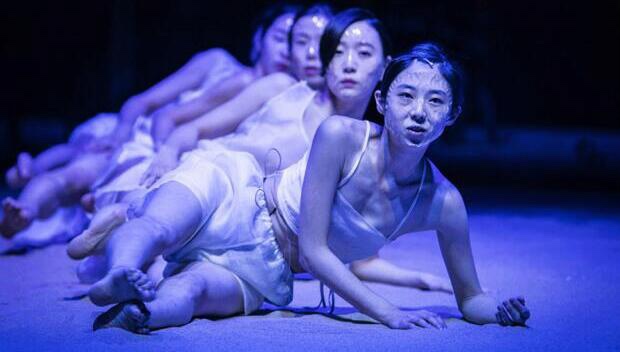By Sunhi Keller
From performers deconstructing a piano and gender politics to dances erasing certain senses and heightening others, the 2022 A Festival of Korean Dance held at The Place offered an enriching curation of selected works from South Korea: Muak by Bora Kim, Sense of Darkness by Soo Hyun Hwang, Tongue Gymnastics by Yun Jung Lee, and Miin: Body to Body by Jinyeob Cha / collective A. All four female choreographers brought a unique perspective as Korean artists to the current political climate, pushing the boundaries of soundscape, gender roles and cultural tradition.
Opening the festival was Bora’s Muak, featuring an ensemble of dancers dismantling an old piano sitting centre stage under styrofoam wrapping and packing tape. One by one, the performers step up to the piano to tear, slash, slam, poke, pound, scream at, climb across it. The destruction becomes more and more aggressive — one dancer even takes a screwdriver out, undoing the piano at its seams. In the process, the piano transforms from an unmoving object into a living entity as it is being thrashed and throttled, exhibiting sounds from its pounding keys to the slamming of dusty wood. Their actions become increasingly aggressive — one dancer even stabs the piano at the seams with a screwdriver— eliciting sounds of violence from the dying piano, the pounding of keys to the slamming of dusty wood. Once the piano is fully destroyed, the performers pile the parts into a heap onstage, where its old, intact ghost once sat. They sit with their backs to the audience, staring at the discombobulated piano, transforming the pieces through rearrangement. The term Muak, translated to English, refers to music performed during a shamanistic ritual where, through ecstatic dance, the shaman transforms herself into a vessel for the voice of the spirits. In Muak, the destruction of the piano (an object that has historically accompanied dance) becomes the music, as opposed to the conventional source of music coming from playing keys. Bora’s dancers have dismantled an object that usually controls their rhythm, beats, and timing and created a soundscape that challenges the concept of constructed melody.

Sense of Darkness and Tongue Gymnastics were placed side by side on a double bill, with both pieces addressing and playing with the senses, using synesthesia to embody the confusion of cross-cultural communication. In Hwang’s Sense of Darkness, four women dressed in black enter the stage, their eyes closed. As they travel through space, holding hands and interspersing fluid slower movements with sudden jolts and rocking, they build a crescendo of sounds, communicating through screeches, chirps, and humming. Hwang structures her piece around a “lost” sense — and the sense of loss — reinforcing the importance of connecting through sound and touch while moving blindly across an unknown landscape.
In Tongue Gymnastics, Lee and Eun Joung Im play with the dancing tongue as a metaphor for language. To the beat of a metronome, they stand next to one another, using their tongues to push and probe their cheeks and lips into dynamic shapes, starting and stopping together. Lee and Im bring out music stands and chairs to sit down next to each other. They begin reading off the sheets of music and over pronounce their tongue movement to produce noises and words foreign to the Korean language — they practice their Ls and Rs. To finish off their sound rehearsal, they suck on lime slices, their faces projecting visceral reactions to the sour taste — scrunched up eyes and pursed lips — echoing the sour taste of unfamiliar sounds in their mouths. Mimicking the movements of their mouths, the dancers then push each other into a duet physicality of their tongues.
The final show of the festival, Miin: Body to Body, addresses the gender politics women face within South Korea, a country notorious for its skincare regimens, plastic surgery, and idealised beauty standards. Miin means beauty, most often used to refer to ‘beautiful women’. Five women and one man take the stage, which is covered in a circular layer of fine sand. The dancers are dressed in white with clear sheets on their faces to mimic facial sheet masks, a visual representation of the societal pressures of needing flawless skin, a beautiful face. Their movement plays between simple walking and more intricate, unified floorwork. As four of the women dance together in the sand, one woman sits watching, dressing herself in a suit (a symbol of masculinity) as the man stays off to the side of the sand, fluctuating between dancing on his own and circling the women.
Cha intersperses words, dance, visual projections, and live music to narrate feminine identity, beauty standards, and societal expectations of women. Towards the beginning of the piece, one of the performers tells the story of the mother cuckoo birds — connecting them to the history of “female hysteria” , emphasising the power of words (“cuckoo”) and how language has been used to diminish women. Upstage, behind the dancers Eunyong Sim plays the geomungo, a traditional Korean stringed instrument, over electronic music composed by haihm. Sim is a classically trained geomungo musician, historically played only by men. Throughout the work, she strikes and pounds the strings of the geomungo, breaking tradition not only in gender, but also in the “delicacy” of how one should play, just like how the performers dance between pedestrian and physicality, power and fragility.
The 2022 Korean Festival showcased four transformational works choreographed by women, each of which engaged their audiences with questions regarding conventions of gender, culture, and tradition. While each of these pieces conveyed aspects of personal experience, they also portrayed an overarching theme of how culture is continuously changing, and how we can persevere in challenging societal norms through dance and performance.
